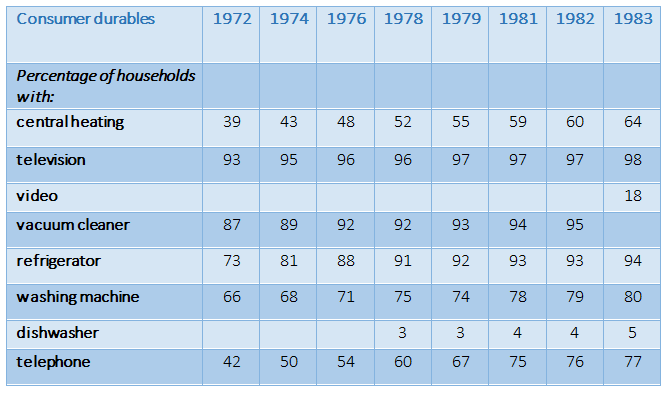You should spend about 20 minutes on this task.
The table below shows the consumer durables (telephone, refrigerator, etc.) owned in Britain from 1972 to 1983.
Write a report for a university lecturer describing the development of the village.
You should write at least 150 words

Sample Answer 1:
The chart shows that the percentage of British households with a range of consumer durables steadily increased between 1972 and 1983. The greatest increase was in telephone ownership, rising from 42% in 1972 to 77% in 1983. Next came central heating ownership, rising from 37% of households in 1972 to 64% in 1983. The percentage of households with a refrigerator rose 21 % over the same period and of those with a washing machine by 14%. Households with vacuum-cleaners. televisions and dishwashers increased by 8%, 5% and 2% respectively. In 1983. the year of their introduction, 18% of households had a video recorder.
The significant social changes reflected in the statistics are that over the period the proportion of British houses with central heating rose from one to two thuds, and of those with a phone from under a half to over three-quarters. Together with the big increases in the ownership of washing machines and refrigerators, they are evidence of both rising living standards and the trend to lifestyles based on comfort and convenience.
Sample Answer 2:
The provided table represents information on the percentage of consumer devices owned by British people from 1972 to 1983. Generally speaking, the most popular electronic item in Britain was television, whereas the less owned household appliances were dishwasher and video which had been introduced to the British families later in 1978 and 1983 respectively.
As for the table data, TVs and vacuum cleaners were always popular in English families with their ownership percentages of 93 and 87 respectively in 1972. A similar ownership pattern for refrigerators and washing machines denotes their popularity as well. Other electronic household appliances’ usages in English families increased in the given period and this rising trend was more significant for telephone and central heating devices. Videos were introduced in 1983 and only 18% British families had it then. A similar trend could be observed for the dishwashers – though it appeared in 1978, not more than 5% British family possessed it in 1983.
Sample Answer 3
The given table compares eight different consumer products possessed by the British between 1972 and 1983. As a whole, television was the most common item they were using during this period, while dishwasher, which was introduced in 1978, was the least popular durable product in the UK.
It can be seen that television and vacuum cleaner were those two devices consumed more than the other ones, from 1972 to 1983. About the former, it ranged from 93% to 98% and the latter from 87% to 95% ownership in Britain. Furthermore, the figures of both groups gradually rose.
In contrast, dishwasher and video were the least favourable durable during 1972 to 1983. 3% of British citizens began using the dishwasher in 1978, reaching the maximum of 5% in 1983. In addition, the video became a durable electronic device since 1983, and only 18% of these people used it. On the other side, usage of all of the other products, including washing machine, refrigerator, telephone or central heating steadily grew. In this case, the percentage for central heating had the greatest growth, rising from 33% in 1972 to almost twice in 1983.

Be First to Comment